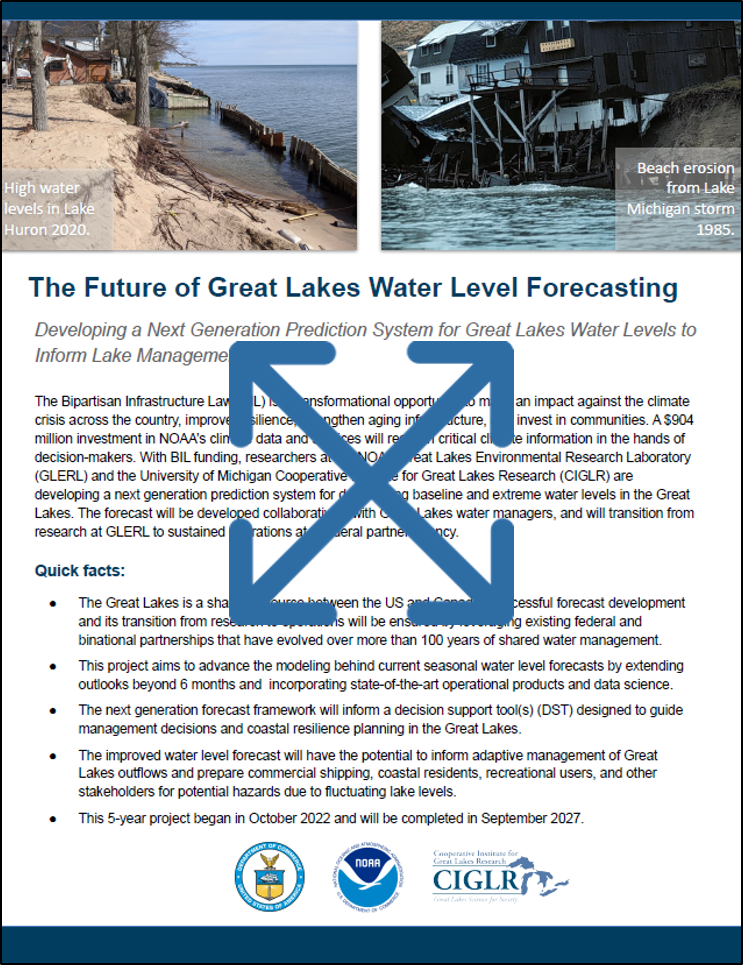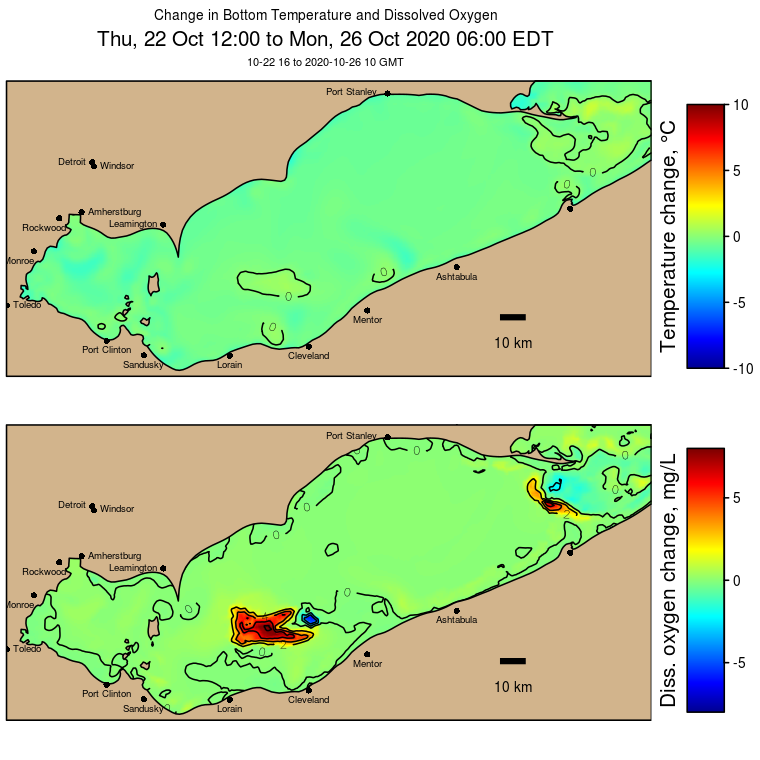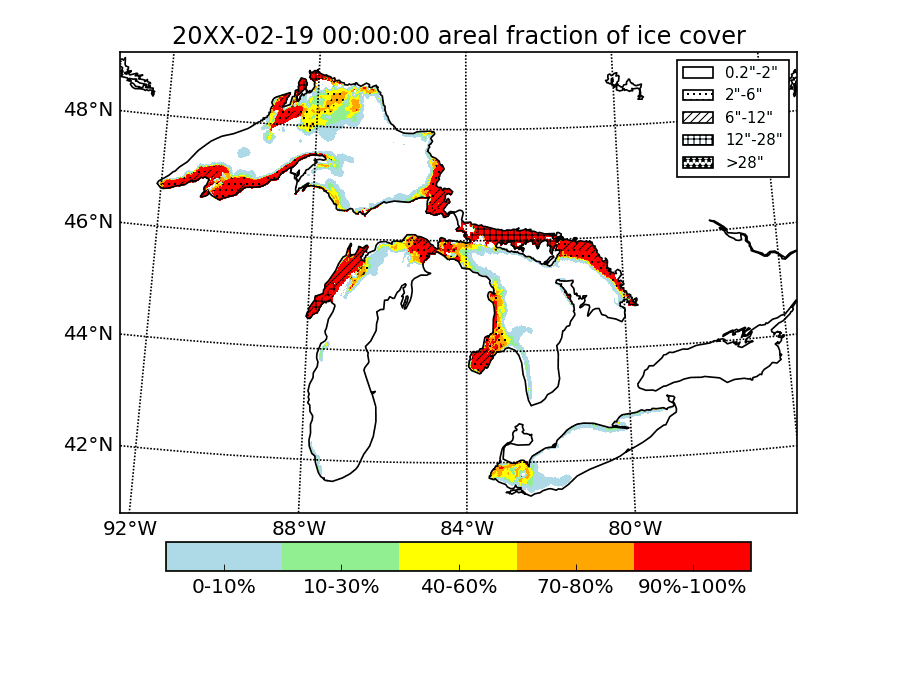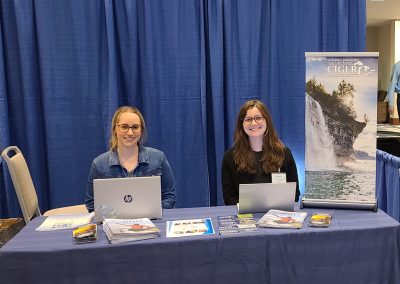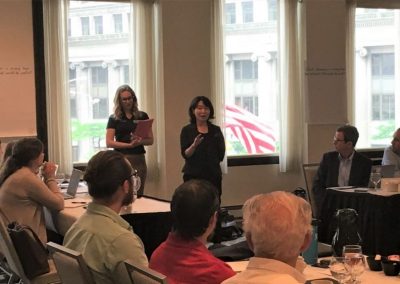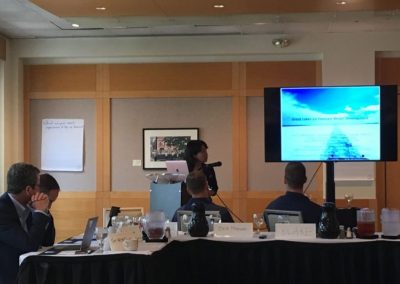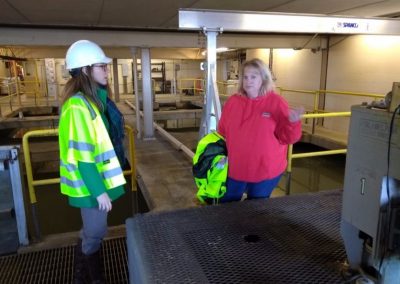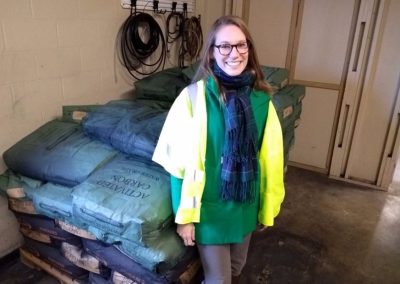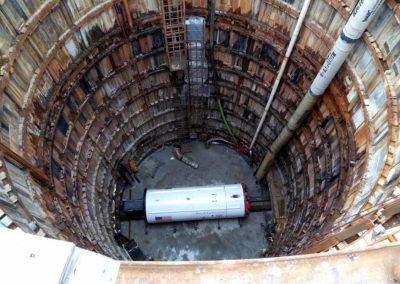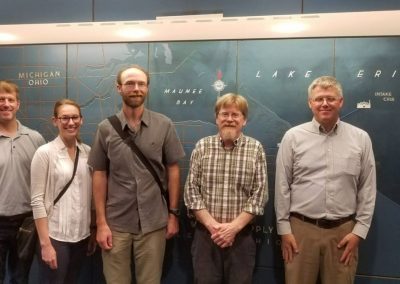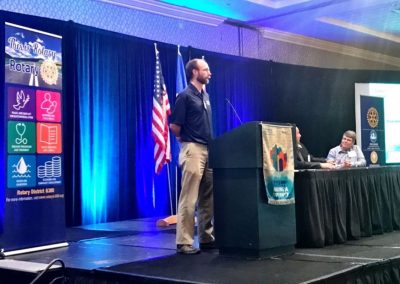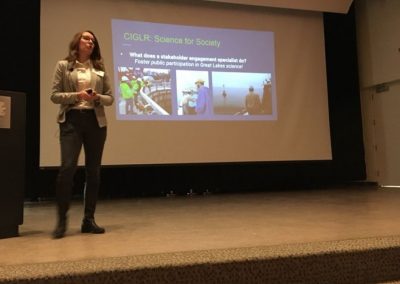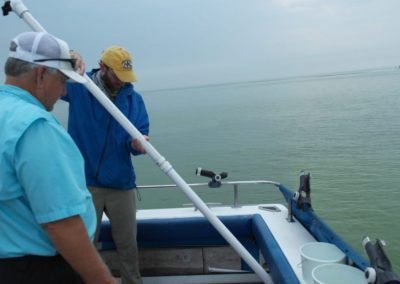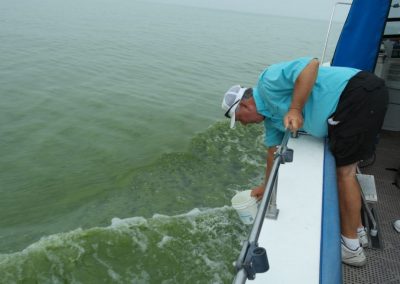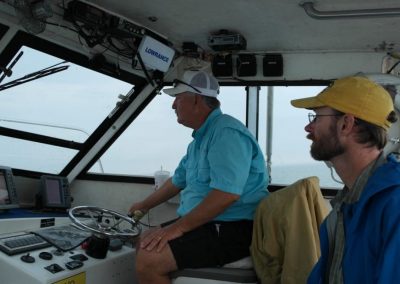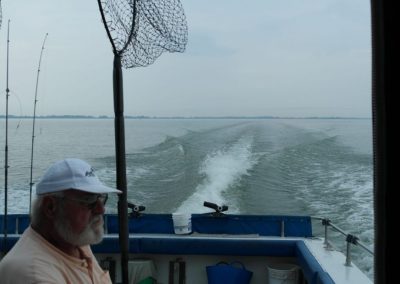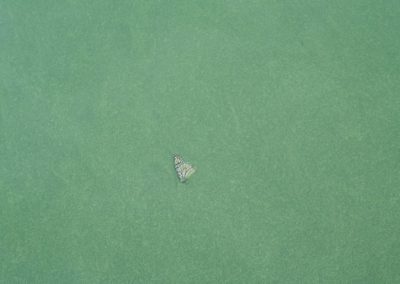Research Engagement
The Research Engagement Team at CIGLR helps scientists collaborate with stakeholders & rights holders to turn research into action for the Great Lakes community.
 Have you ever looked for information about Great Lakes water conditions to make a decision? If the answer is yes, then you are a CIGLR stakeholder! Our stakeholders include community groups like anglers, ship captains, public water system operators, beach goers, public health professionals, natural resource managers, and many others.
Have you ever looked for information about Great Lakes water conditions to make a decision? If the answer is yes, then you are a CIGLR stakeholder! Our stakeholders include community groups like anglers, ship captains, public water system operators, beach goers, public health professionals, natural resource managers, and many others.
Research engagement is a two-way interaction between researchers & end-users for the mutually beneficial development & transfer of knowledge. When stakeholders, rights holders, and end-users engage in the development of research projects and products, we are able to achieve our engagement goals:
-
- Create Great Lakes research products that answer critical stakeholder questions and meet their most pressing information needs.
- Ensure that our research products are easy to use, easy to access, and appreciated by end-users
- Facilitate positive and effective communication between Great Lakes scientists and stakeholders, rights holders, and end-users
- Build CIGLR’s reputation in the region as an authority on Great Lakes research, and a resource for community groups
1. Water Level Modeling & Prediction
2. Harmful Algal Blooms
CIGLR and GLERL’s harmful algal blooms (HABs) research team have incorporated stakeholder engagement efforts into the development of research priorities and products, including the Experimental Lake Erie HAB Tracker.
Lake Erie HAB Tracker: In 2016, CIGLR conducted focus groups with recreational anglers and charter captains to understand the decisions they make related to fishing during harmful algal blooms (HABs). Participants varied in their perceptions of health risks and the impacts of HABs on fish, but all agreed that they prefer to avoid fishing in HABs because it detracts from the overall fishing experience. This was valuable information for scientists developing the Experimental Lake Erie HAB Tracker, a decision-support tool that predicts bloom occurrence over a five-day period. By engaging people who are impacted by HABs during the development process, scientists were able to design this product in a way that ensures that it is useful. The Experimental HAB Tracker was transitioned to the operational Lake Erie HAB Bulletin in 2020, where it continues to support recreation in Lake Erie by identifying locations with clear water.
Monitoring HABs in Saginaw Bay: CIGLR has partnered with Michigan Sea Grant and other regional stakeholders in the Saginaw Bay watershed to understand information needs related to Saginaw Bay HABs. In 2019, a workshop was held to explore stakeholder concerns regarding the blooms, share CIGLR monitoring data for Saginaw Bay, and explore interest in the development of research products for Saginaw Bay. Work to understand the state of HABs in Saginaw Bay and related stakeholder information needs is ongoing.
3. Hypoxia
CIGLR and the NOAA Great Lakes Environmental Research Lab are partnering with Cleveland Water and other Ohio public water systems to develop a hypoxia forecast for the central basin of Lake Erie. Prolonged periods of hypoxia can increase levels of manganese in the water. When this water infiltrates public water intakes, it creates public health risks and increases the difficulty of drinking water treatment. This short-term forecast will give predictions of hypoxia events at the time scale of a typical weather forecast (5-10 days. The hypoxia forecast is active from July to October, and provides advance warning of hypoxic events to drinking water treatment plants that draw their water from Lake Erie. By planning ahead for treatment actions, plant operators will be better prepared to respond to changes in source water quality.
4. Ice Forecasting
CIGLR and NOAA GLERL are working to improve the usability of NOAA’s Great Lakes Operational Forecast System (GLOFS) by including stakeholders in the design of a Great Lakes Ice Forecast. An easy-to-use ice forecast will be designed to help lake vessels and the 9th District U.S. Coast Guard (USCG) navigate dangerous ice conditions, prepare for emergency responses, and reduce risk of vessel damage due to ice. Workshops, surveys, and focus groups continue to be conducted to assess information needs and develop a forecast user interface. A stakeholder engagement report for the Great Lakes Ice Forecast workshop held on July 11th, 2019 in Cleveland can be read here.
In addition, the team continues to conduct interviews and focus groups in the follow-on project in collaboration with Great Lakes Integrated Sciences and Assessment (GLISA). The final report from this follow-on project is expected to be available in April 2022.
Stay up-to-date on the most recent news and scientific media generated from our Research Engagement Team here:
News
Harmful Algal Blooms
- Underwater Robot Labs Monitor Toxins; Smithsonian.com, 8/10/2017
- Underwater Lab Helps Fight Lake Erie Algae; The Wall Street Journal, 7/24/2017
- New robotic lab tracking toxicity of Lake Erie algal bloom; Michigan News,7/19/2017
- Algae Bloom Tracker Developed by Anglers & Boaters (Radio Interview); Afternoon News on iheartradio, 7/14/2017
- New Tool for the Tackle Box: An Algal Bloom Tracker; Great Lakes Connection, 7/10/2017
- Severe algae bloom forecast; The Advertiser-Tribune, 2/17/2017
- Scientists launch “lab in a can” to detect toxins in Lake Erie; Michigan Radio, 9/15/16
- A “lab-in-a-can” could pioneer protection network for Great Lakes water; Great Lakes Echo, 9/9/16
- NOAA, partners predict smaller harmful algal bloom for western Lake Erie; NOAA.gov, 7/7/2016
- Stay out of the scum, warns NOAA’s latest bulletin on Lake Erie’s Harmful Algal Bloom; Climate.gov, 8/19/2015
- Hear from the scientists who saw the Ohio algae blooms coming; PBS Online, 8/3/2014
- Lake Erie: big algae problems, more to come; Christian Science Monitor, 4/2/2013
- Record-Setting 2011 Lake Erie Algae Blooms Could Become The New Norm; RedOrbit, 4/2/2013
- 2011 Lake Erie algae bloom an omen of worse to come: report; CTVNews, 4/2/2013
- Report Predicts Ever-Bigger Lake Erie Algae Blooms; CBS Detroit, 4/2/2013
- Extreme algae blooms: The new normal?; EurekAlert!, 4/10/2013
- Record-breaking 2011 Lake Erie algae bloom may be sign of things to come; EurekAlert!, 4/1/2013
- Extreme algal blooms: The new normal?; EurekAlert!, 4/1/2013
Hypoxia
- New Study Provides Better Understanding of Lake Erie ‘Dead Zone’; WEMU 89.1, 2/22/2021
- Release of nutrients from lake-bottom sediments worsens Lake Erie’s annual ‘dead zone,’ could intensify as climate warms; Michigan News, 2/19/2021
Ice Forecasting
jnjn
- Researchers to sharpen Great Lakes ice alerts, Great Lakes Echo, 2/27/2019
Publications & Presentations
Lower, E., Sturtevant, R. and Gill, D. 2020. Sharing Feedback, Sharing Screens: Videoconferencing as a Tool for Stakeholder-Driven Web Design. Journal of Extension.
Harmful Algal Blooms
Presentations
- Johengen, T. 2019. A review of Saginaw Bay Water Quality and Harmful Algal Bloom Monitoring. [Presentation]
- Rowe, M. 2019. Development of an Experimental Harmful Algal Bloom Forecast for Saginaw Bay. [Presentation]
- Devin Gill. 2019. Assessing Community Need for a Saginaw Bay Harmful Algal Bloom Forecast [Presentation]. International Association for Great Lakes Research Annual Conference.
- Stow, C. 2019. Saginaw Bay Harmful Algal Blooms – Nutrient Status. [Presentation]
- Rowe, M. 2019. Saginaw Bay Harmful Algal Bloom Forecast. [Presentation]
- Tompkins, J. 2018. Focus Group Presentation. [Presentation]
- Devin Gill (September 26, 2018). Using Knowledge Coproduction to Engage Stakeholders in Great Lakes Research [Webinar]. In USGS Lower Mississippi Gulf-Water Science Center Science Seminar.
- Gill, D. 2017. Predicting Harmful Algal Blooms (HABs) in Lake Erie: HAB Tracker. [Presentation]
- Devin Gill. 2016. Understanding the Harmful Algal Bloom Forecasting Needs of Lake Erie Anglers [Presentation]. International Association for Great Lakes Research Annual Conference.
Publications
- Gill, D., M. Rowe, and S. Joshi. 2018. Fishing in Greener Waters: Understanding the impact of harmful algal blooms on Lake Erie anglers and the potential for adoption of a forecast model. Journal of Environmental Management (227): 248-255. (DOI:10.1016/j.jenvman.2018.08.074).
- Guo, T., D. Gill, T.H. Johengen and B.J. Cardinale. 2019. What determines the public’s support for water quality regulation to mitigate agricultural runoff? Environmental Science and Policy. (101):323-330. (DOI:10.1016/j.envsci.2019.09.008).
Hypoxia
Presentations
- Devin Gill. 2018. Applying Natural Science and Social Science to Co-produce a Hypoxia Forecast with Public Water Systems [Presentation]. International Association for Great Lakes Research Annual Conference.
- Rowe, M. 2018. Experimental Lake Erie Hypoxia Forecasting for Public Water Systems Decision Support. [Presentation]
- Stow, C. 2018. Saginaw Bay Harmful Algal Blooms: Nutrient Status. [Presentation]
- Gill, D. 2018. Experimental Lake Erie Hypoxia Forecast Focus Group & Evaluation Survey Results. [Presentation]
- Rowe, M. 2018. Hypoxia in Lake Erie: An Overview. [Presentation]
- Rowe, M. 2018. Developing a Hypoxia Forecast Model for the Central Basin of Lake Erie. [Presentation]
Ice Forecasting
Presentations
- Gill, Devin, Ayumi Fujisaki-Manome, Kripa Jagannathan, Maria Lemos. 2020. Improving Environmental Forecast Models through Stakeholder Engagement. [iPoster].
- Devin Gill. 2019. Assessing Stakeholder Need for a Short-Term Great Lakes Ice Forecast. [Presentation]. 2019 Great Lakes Ice Conference held by the 9th District US Coast Guard.
- Fujisaki-Manome, A. 2019. Great Lakes Ice Forecast Model Development. [Presentation]
Publications
Research Engagement Specialist:
Nayethzi Hernandez
Research Engagement Specialist:
John McClure
Research Engagement Photo Gallery
Research Engagement Program Lead Riley Ravary (R) and Research Engagement Specialist Megan DiCocco (L) at the 2023 IAGLR conference in Toronto.
CIGLR Stakeholder Engagement Specialist Devin Gill (left) and Assistant Research Scientist Dr. Ayumi Fujisaki-Manome (right) at the Great Lakes Ice Forecast Needs Assessment Workshop. Photo Credit: Devin Gill.
CIGLR Stakeholder Engagement Specialist Devin Gill (middle) at the Great Lakes Ice Forecast Needs Assessment Workshop. Photo Credit: Devin Gill.
Assistant Research Scientist Dr. Ayumi Fujisaki-Manome at the Great Lakes Ice Forecast Needs Assessment Workshop. Photo Credit: Devin Gill.
Devin Gill getting a tour of the Painesville Water Treatment Plant. CIGLR’s Mark Rowe and Devin Gill met with Painesville Water Treatment Plant to talk about impacts of Lake Erie hypoxic (dead zone) water on drinking water (taste, odor, discoloration issues). CIGLR & NOAA GLERL are developing a forecast to help plant operators respond to hypoxic water intrusion. Photo Credit: Mark Rowe.
Devin Gill getting a tour of the Painesville Water Treatment Plant. CIGLR’s Mark Rowe and Devin Gill met with Painesville Water Treatment Plant to talk about impacts of Lake Erie hypoxic (dead zone) water on drinking water (taste, odor, discoloration issues). CIGLR & NOAA GLERL are developing a forecast to help plant operators respond to hypoxic water intrusion. Photo Credit: Mark Rowe.
Devin Gill getting a tour of the Painesville Water Treatment Plant. CIGLR’s Mark Rowe and Devin Gill met with Painesville Water Treatment Plant to talk about impacts of Lake Erie hypoxic (dead zone) water on drinking water (taste, odor, discoloration issues). CIGLR & NOAA GLERL are developing a forecast to help plant operators respond to hypoxic water intrusion. Photo Credit: Mark Rowe.
Painesville Water Treatment Plant. CIGLR’s Mark Rowe and Devin Gill met with Painesville Water Treatment Plant to talk about impacts of Lake Erie hypoxic (dead zone) water on drinking water (taste, odor, discoloration issues). CIGLR & NOAA GLERL are developing a forecast to help plant operators respond to hypoxic water intrusion. Photo Credit: Mark Rowe.
Scientists and partners from LimnoTech, the NOAA Great Lakes Environmental Research Laboratory and CIGLR meet with chemists and managers at the Toledo Water Treatment Plant. We work together to improve data communication, and to support and prepare the City Of Toledo for the 2017 algal bloom season. Photo Credit: Devin Gill.
Dr. Mark Rowe speaking to the Ann Arbor/Ypsilanti #rotaryclubs about the need for #HAB forecasts to address harmful algal blooms in #LakeErie. Photo Credit: Devin Gill.
Devin Gill shows how citizen science can help us understand and prevent Great Lakes harmful algal blooms. Photo Credit: Michigan Office of the Great Lakes. Photo Credit: Devin Gill.
Devin Gill discusses the CIGLR Great Lakes Summer Fellowships and Graduate Research Fellowships with a prospective student at the 2018 Green Career Fair hosted by The University of Michigan. With increasing concerns about climate change and environmental degradation in contemporary society, there is a demand for environmentally conscious careers. Applying skills to an environmental position can provide fulfilling experiences that encourage sustainable thinking in future career paths and benefit the environment as a whole. This event is structured similarly to other career fairs, but participating employers are hiring for positions with an environmental and sustainability focus. Photo Credit: Michele Wensman.
CIGLR Assistant Research Scientist Dr. Mark Rowe helps collect a sample with charter boat captain Don McGee. (September 8, 2017). Photo Credit: Devin Gill.
Charter boat captain Don McGee reaches over to grab a bucket sample of water. (September 8, 2017). Photo Credit: Devin Gill.
L-R: Charter boat captain Don McGee and CIGLR Assistant Research Scientist Dr. Mark Rowe collecting water samples from Lake Erie. (September 8, 2017). Photo Credit: Devin Gill.
A very green September cyanobacteria sample from Lake Erie (September 8, 2017). Photo Credit: Devin Gill.
Video Library
Hear former Stakeholder Engagement Specialist, Devin Gill, talk about her important work to connect research teams with data users ensures that our products are useful and relevant to society in the video below. “My goal as the stakeholder engagement specialist is to build a relationship between scientists and community groups to ensure that we’re all working together to promote this hugely important resource, the Great Lakes,” says Devin.
Video Library
“We want to begin speaking with community members, stakeholder groups from the get-go to understand what their interests are, what their problems are in dealing with water quality. So, that we’re working with them to develop solutions,” says former Stakeholder Engagement Specialist Devin Gill during an interview with the Ocean Conservancy.
.

